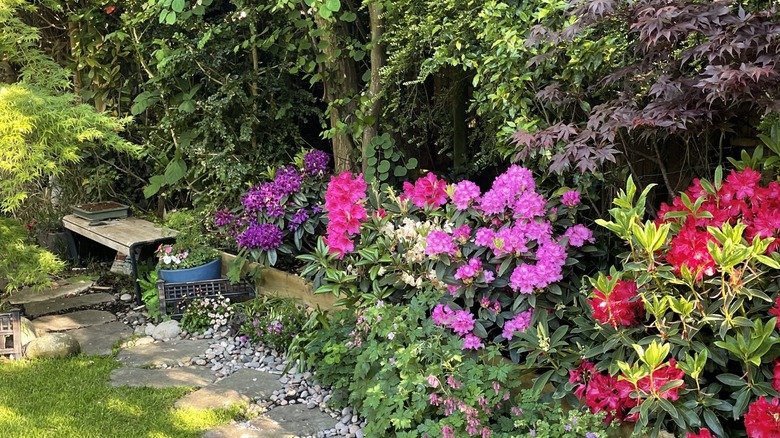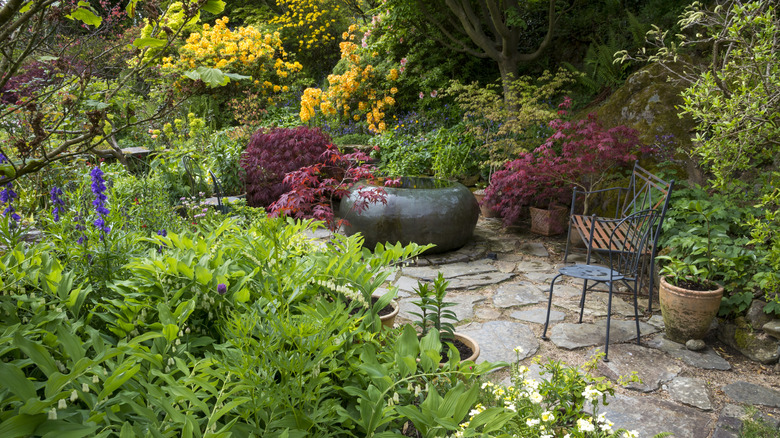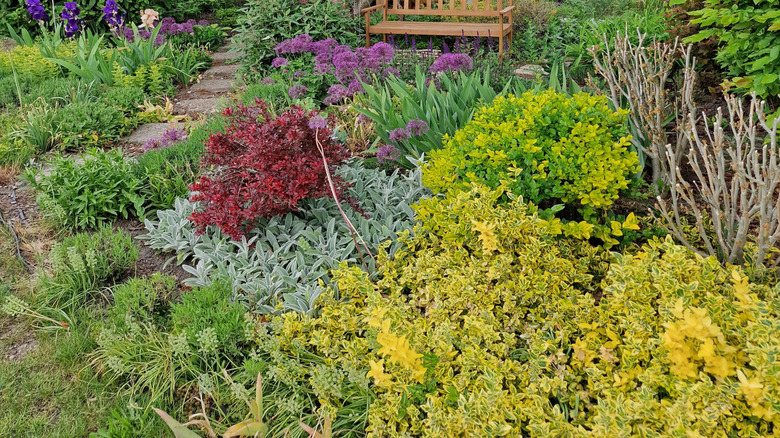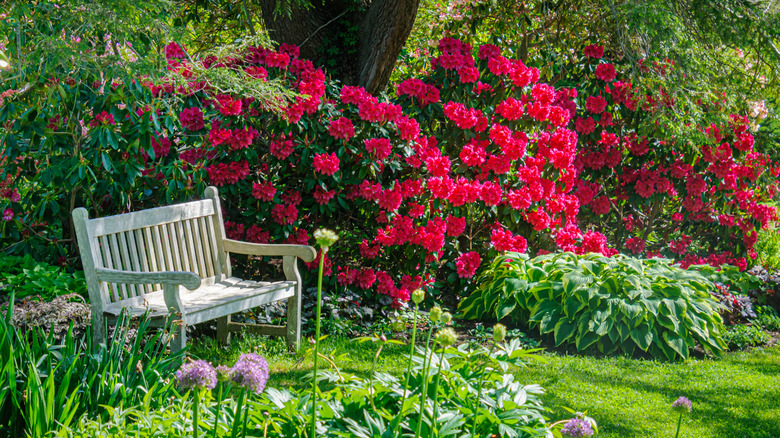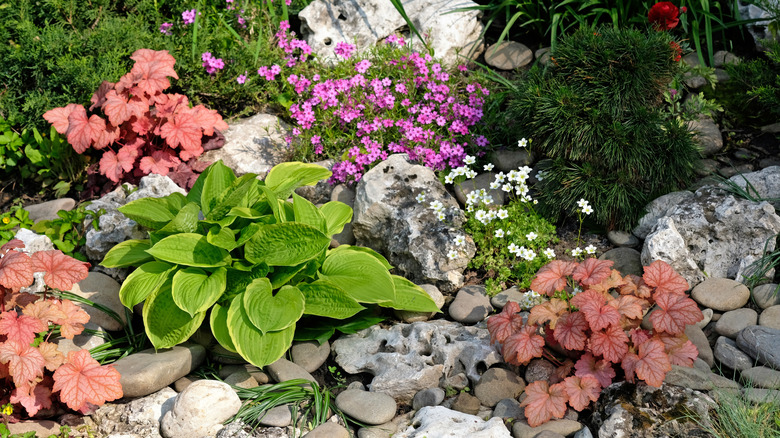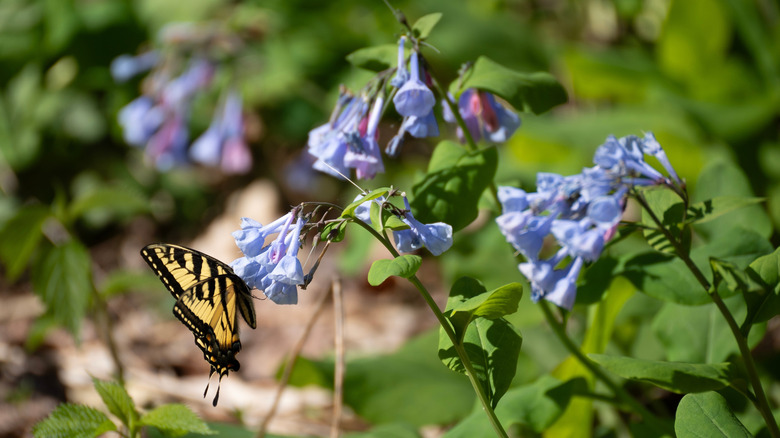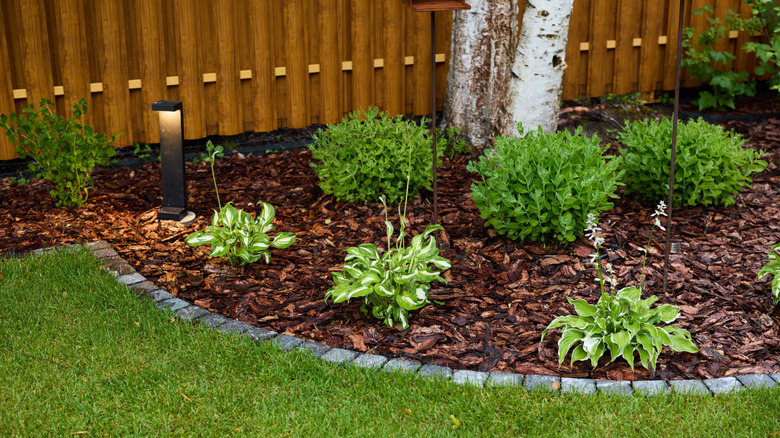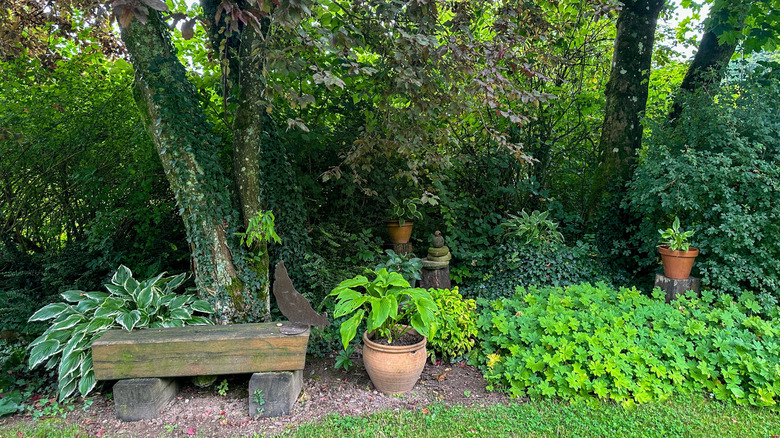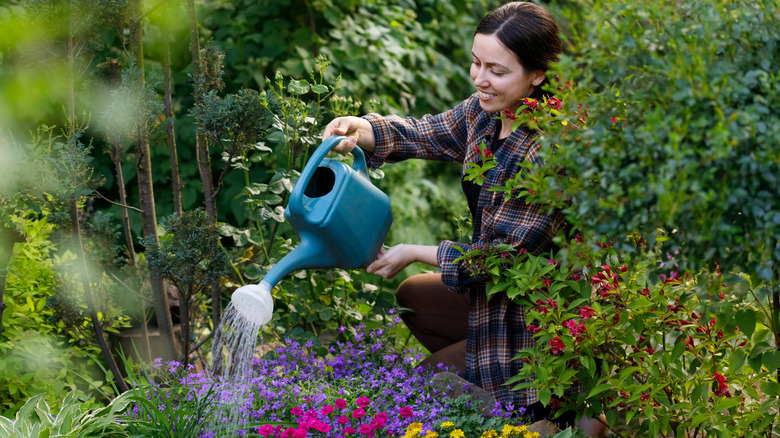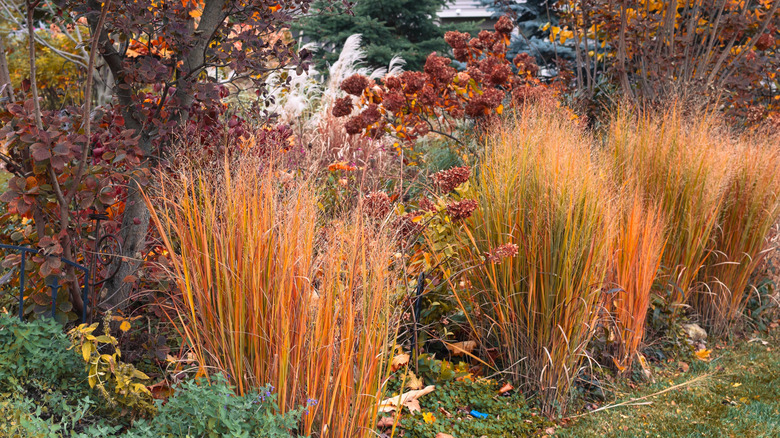How To Grow A Gorgeous, Healthy Shade Garden (And 4 Mistakes To Avoid)
Perhaps you have a giant shade tree in your backyard where grass has stopped growing, or maybe you just want a colorful space to cool off and relax in during hot summers. Whatever your reason may be, designing a shade garden is a great way to brighten up those dark areas on your property. Although many plants require ample sunlight to flourish, there are several trees, shrubs, perennials, and groundcovers that don't just tolerate shade, but thrive in it. As a bonus, filling up those shady areas is a great way to provide food and habitat for wildlife, naturally attracting hummingbirds, butterflies, songbirds, and bees.
Although you may be excited to head to your local garden center to look for pretty plants that thrive without direct sunlight, it's important to create a plan before getting started. Shade gardens require thoughtful consideration, so you can make selections that stand out, despite being in low-light areas. Additionally, although shade plants are generally low-maintenance, they can be a little picky about their environment. By understanding the different light levels plants require, the care needs of different species, design strategies, and other factors, you can create a shade garden that is as healthy as it is gorgeous. We'll walk you through everything you need to know below, so you can feel confident as you transform that shaded area into your new favorite part of your yard.
Understand the different types of shade
One of the most important aspects of designing a shade garden is understanding the different types of light. Partial or light shade plants thrive when they receive around 3 to 6 hours of sunlight per day, with many preferring some protection from the sun during hot afternoons. Plants that prefer dappled shade grow best underneath trees with sunlight filtering through a tree canopy for most of the day. Although there aren't as many, there are even some plants that have adapted to extremely shady conditions, like areas where the sun is blocked off by a building. Generally, full shade varieties can handle less than three hours of direct sun, while deep shade plants can grow even if there's almost no sunlight, though they still need some light to photosynthesize.
The best way to know how much light each area receives is to spend a few days watching the shadows. Take photos each hour from sunrise to sunset and jot down how many hours of sun each spot receives. Once you have an idea of the light levels in your yard, you can choose plants that will thrive in each of the areas. Hostas, ferns, and impatiens (Impatiens walleriana) are some of the most popular shade plants, as there are varieties that can thrive in deeply shaded areas. On the other hand, species like azaleas (Rhododendron), coral bells (Heuchera), and old-fashioned bleeding heart (Lamprocapnos spectabilis) are perfect for areas that get partial sun or dappled light.
Pay attention to the microclimates in your yard
You may already know the importance of choosing plants within your USDA growing zone, but you may be surprised to learn that your garden has microclimates, which can be vastly different from your local climate. For example, shade plants underneath an overhang that blocks rain can be drier, while a low-lying corner is likely to collect moisture and stay cooler than the rest of your garden. Water features, like a pond or fountain, can increase the humidity in the nearby air as water evaporates, which can also make these areas cooler. On top of that, slopes or hills can affect the amount of wind and sunlight, creating pockets of varying temperatures and humidity levels.
To determine where the microclimates are in your yard, pay attention to how the sunlight, temperature, and moisture vary throughout the day and seasons. Use a thermometer and moisture meter to track the temperature and soil moisture levels. Once you have an idea of your garden's quirks, you can make better planting choices. For instance, low-lying areas that collect water are great for moisture-loving plants, like wild ginger (Asarum canadense). Because humidity will be higher near water features, plants like begonias will thrive in these spots. Drought-tolerant species, like yellow archangel (Lamium galeobdolon), are perfect for areas with dry shade. It may take some effort to identify the different conditions, but by working with the microclimates, you can create a shade garden that effortlessly thrives.
Design your shade garden in layers
It can be overwhelming to look at the blank canvas of an unplanted space. Surprisingly, the easiest way to design your shade garden also happens to benefit the environment by supporting native insects and birds, all while looking beautiful and intentional. The key is mimicking nature and arranging your plants similarly to the way they naturally grow in a forest. Starting with taller backdrop plants and filling out the front with lower-growing species creates a layered effect, adding depth and visual interest to your shade garden.
When possible, choose native species. Natives aren't just great for supporting biodiversity, but because they've adapted to local climates, they're also often easier to care for. Start with your tallest shade tree at the back of your garden to create a canopy. Below, plant understory trees or shrubs, like flowering dogwood (Cornus florida) or azaleas (Rhododendron). In front of those, you can add lower-growing shade plants, like hostas, coral bells (Cobaea scandens), foam flower (Tiarella), or ferns. Finally, you can fill in the spaces with wild stonecrop (Sedum ternatum), allegheny spurge (Pachysandra procumbens), or other ground covers to add even more color and texture. You can apply this layered pattern to other shady parts of your yard, using taller plants to soften the structure and filling out the remaining areas with low-growing plants.
Make use of foliage plants in a variety of colors and textures
Just because you're gardening in the shade doesn't mean you can't add lots of bold colors; it just may look different than it does in a sunny bed. While there are some shade plants with vibrant blooms, pigmented flower colors are rarer in these species than in sun-loving varieties. Plus, while several flowering species will grow in shade, they often don't flower as profusely. Luckily, there are dozens of plants that are popular for their uniquely shaped foliage, colorful leaf patterns, or interesting textures. Flowers fade, but foliage plants can offer constant color throughout the seasons.
Adding a bunch of similar-looking foliage plants next to one another can create a flat, uninspired look. Instead, have fun choosing plants that contrast with those next to them. For example, red- or purple-pigmented leaves, like those on some Heuchera varieties, will pop beautifully next to plants with lush green foliage. In shade gardens, leaves and flowers with light colors will stand out the most, so focus on utilizing plants with these features. Plants with deep, darker hues can get lost in the dimly lit areas, so use them sparingly and pair them with plants in light shades to maintain brightness. Working with various textures is another great way to keep your shade garden visually interesting. Balance out smooth, wide-leaved plants, such as hostas, with fine-textured foliage, like that on ferns.
Leverage spring ephemerals
You don't have to wait for the weather to warm up before enjoying flowers in your shade garden. The secret is planting a few spring ephemerals, which are native woodland flowers that have adapted to sprouting up early in the year before the trees fill with leaves and block the sun. As the trees leaf out, the pretty plants go dormant until the following year. These early-season perennials aren't just great for adding more color to your shade garden, but they're also a crucial nectar source for pollinators at a time when few plants are in bloom.
Choose a few native spring ephemerals that thrive in your region and plant them in an area where they'll catch some sunlight before the canopy fills out. Virginia bluebells (Mertensia virginica) are woodland wildflowers with loose clusters of stunning blue flowers that appear in early to mid-spring and mix in beautifully with foliage plants, like hostas. Another option is spring beauty (Claytonia virginica), a low-growing perennial with white or pale pink, star-shaped flowers. They grow well alongside many other native early bloomers, like the white trout lily (Erythronium albidum), Solomon's seal (Polygonatum biflorum), or wild geranium (Geranium maculatum). Because they disappear within a few weeks, you can double plant them with species that bloom later in the year to extend the color in your garden.
Avoid crowding plants too closely
While the windbreak from trees and structures has its advantages, the main drawback is the lack of air movement in shady areas. Additionally, the limited sunlight slows down evaporation, so water hangs around in the air, soil, and on plant leaves for longer than it would in a sunlit yard. Unfortunately, the stagnant air paired with excess moisture creates a recipe for fungal diseases, like powdery mildew or leaf spot. One of the biggest mistakes gardeners make when designing a shade garden is crowding plants too closely, further limiting airflow and trapping even more moisture between their leaves.
When mapping out the layout, don't forget to account for the size of mature plants. Each species has its own unique spacing needs, so check the information labels or seed packets to determine the amount of space that's necessary for each of your plants. In shade gardens, it can be helpful to slightly increase the recommended spacing, giving them even more room to breathe. If the tree branches above your planting area are dense, remove a few of the lower limbs to allow air to flow through more freely. You can also place your more disease-prone varieties towards the outer edges, where there's slightly more air flow. When possible, opt for more disease-resistant cultivars, especially if they're sensitive to humid environments.
Don't disturb tree roots when adding shade plants
Livening up the area around tree roots can be exciting, but you want to make sure you're keeping the health of the tree in mind. In urban settings, it's common for 80% or more of the tree roots to be within the top foot of soil. Many species are sensitive to damage or changes like removing the soil, adding a thick layer of mulch, or cutting into the roots. Unfortunately, even minor disturbances can affect the tree's ability to absorb water and nutrients, which can lead to its decline.
When landscaping around exposed tree roots, start by planning your design around them. As you dig the planting holes, be careful not to cut or nick them when removing soil, as this can lead to decay. Instead, use small hand tools to gently remove layers, and opt for plants with shallow roots to limit the digging depth. For a gentler approach, you can add plugs (miniature plants with roots that are shorter than 5 inches) of a shade-loving ground cover, like bugleweed (Ajuga reptans), which will slowly spread over time. Additionally, you don't want to dump a large amount of soil or mulch near the base; even an extra inch of soil can be enough to cause the bark to rot. If necessary, you can even out the root area with compost, which is less suffocating than soil. Potted plants also work well for tricky spots, and you won't have to deal with them competing with the tree's thirsty roots.
Avoid watering all of your shade plants the same way
Watering shade plants can be a little tricky when you consider the microclimates in gardens. Because shady areas are generally cooler and have limited sunlight, they tend to hold onto more moisture than sunny sites. However, if your plants are growing underneath overhangs, a dense tree canopy, or overhead structures that block the rain, they'll likely need more supplemental water. Additionally, any plants growing near established trees will be forced to compete for moisture, and the soil may dry out more quickly. When you water the area, the tree's roots will absorb it first, leaving less available for neighboring plants.
To keep your shade plants healthy, always check the soil first and deeply water them when the soil is dry. Over time, you'll begin to notice which areas need to be watered more frequently. Because shaded areas can be more susceptible to fungal diseases, do what you can to limit the amount of water that lands on the leaves, otherwise you risk the growth of fungal diseases. Rather than overhead watering, aim your hose directly at the base of the plant. Splashing happens, so it's best to water your plants early in the morning to give the foliage time to dry before the heat of the day. If possible, install an irrigation system that saturates the soil without wetting leaves. Many of these systems have settings that allow you to set a specific time of day and will water your plants for your chosen set duration.
Don't forget to consider each plant's seasons of interest
One mistake many gardeners make is forgetting to take into account how their shade garden will look throughout the year. If you choose plants based on what they look like at their peak and ignore when that will be, you can end up with combinations that clash or leave unbalanced gaps in your garden. By understanding each of your plants' bloom times and seasonal traits, you'll be able to design a shade garden that looks intentional all year long.
First, consider if there is a particular season when you want your shade garden to look its best and what your overall goals are. So, if you know you'll be cooling off in your shade garden during the hot summer heat, you may want to prioritize summer-blooming flowers. On the other hand, if you want your garden to be visually appealing year-round with low-maintenance landscaping, choose several plants that offer multi-seasonal interest, like the American beautyberry (Callicarpa americana). Then, consider what the foliage and flower colors will look like each month, so you can create pairings that continue to work well together. For example, if you have a shrub that blooms in spring, you can use the lush, green foliage as a backdrop for summer-blooming flowers.
